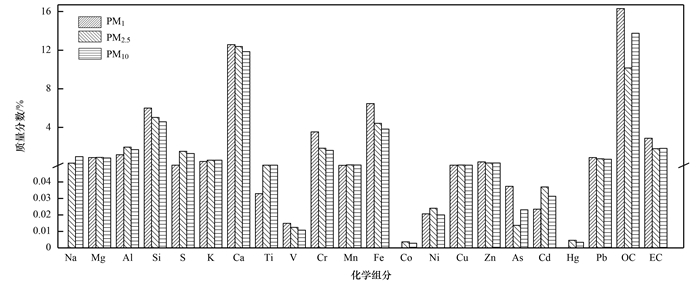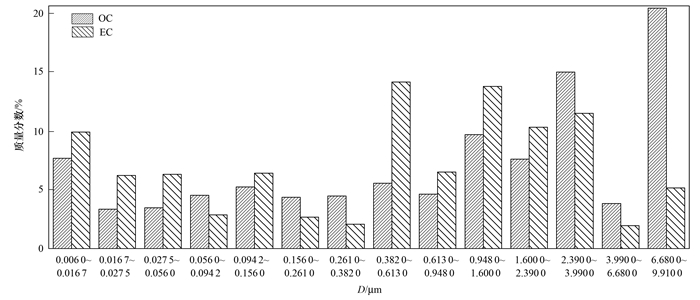2. 武汉市环境监测中心, 武汉 430015
2. Wuhan Environmental Monitoring Center, Wuhan 430015, China
直接填埋法、堆肥法以及焚烧法是处理城市垃圾的主要方式.由于土地资源紧张, 占地面积小而垃圾削减率高的焚烧法成为各国城市垃圾环境无害化处置的必然选择[1, 2], 发达国家城市垃圾焚烧处理率普遍在35%~40%, 一些国家甚至达到70%以上[3].垃圾焚烧处理具有占地少、场地选择容易、处理时间短、减量化显著(减重一般达到70%, 减容一般达到90%)、无害化较彻底以及可回收垃圾焚烧余热等优点[4], 但是垃圾焚烧同时会产生许多大气污染物, 主要有颗粒物(PM2.5及PM10)、酸性气体(NOx、SO2和HCl等)、重金属及其化合物、不完全燃烧产物(CO等)、微量有机化合物(二



随着我国的快速发展, 城市化率不断提高, 每年会产生大量的生活垃圾, 当前我国城市生活垃圾的分类、回收和处理能力与水平发展还相对落后, 垃圾的处理问题十分突出.在我国已有很多城市选择焚烧法处理生活垃圾, 由于飞灰中可能含有重金属等有害物质, 所以对于垃圾焚烧排放颗粒物及其粒径特征研究十分必要.当前对于污染源排放颗粒物中重金属及其粒径特征的研究并不多见, 梁俊宁等[13]对陕西某铅锌冶炼厂不同工艺各粒径段颗粒物中的铅元素含量及粒径分布特征进行分析; Zhang等[14]在湖南省株洲市对铅锌冶炼工厂排放颗粒物采样, 并对其粒径分布和重金属进行分析.对于垃圾焚烧厂排放颗粒物的研究, 张海龙等[15]应用富集因子法、主成分分析法对广东某垃圾焚烧炉周边空气颗粒物中金属进行分析, 发现研究区域Fe与Ni、Cr、Mn、Ba主要来自于焚烧炉释放, Zn、Cd、Pb、Bi和Cu则来自于研究区域周边的交通污染源, 而Al和Mg则主要来自于地壳或土壤背景值; 李娜等[16]采用筛分法研究了重庆市生活垃圾焚烧飞灰中的粒径分布, 分析了各粒径颗粒中Pb、Cd、Zn、Cu、Mn、Ni和Cr等重金属的总量, 结果表明, 90%以上的飞灰粒径小于250 μm, 其中粒径为149~250 μm的颗粒最多, 约占总量的50%.这些研究以垃圾焚烧厂周围环境空气受体为对象, 研究的颗粒物粒径较大, 均在53 μm以上, 不能详细了解垃圾焚烧实际排放颗粒物的粒径分布特征.
垃圾焚烧厂颗粒物的排放与垃圾的性质有关, 还受到垃圾运动速度、空气过剩系数、烟气停留时间、炉内气体湍流度、活性炭等因素影响[17], 颗粒物中重要组分的粒径分布特征是十分重要的信息, 这些因素也会对颗粒物的粒径分布造成重要影响.本研究采用静电低压撞击器(ELPI+)对垃圾焚烧厂排放颗粒物进行采集, 分析颗粒物中的元素和碳组分及其在14个粒径段的粒径特征, 并建立垃圾焚烧厂源PM1、PM2.5和PM10的元素和碳组分成分谱, 以期为颗粒物的精细化来源解析及其他相关研究提供参考.
1 材料与方法 1.1 样品采集选取武汉市汉口某垃圾焚烧厂采集样品.该垃圾焚烧厂主要处理汉江、江岸、硚口、东西湖以及黄陂南部等江北地区的生活垃圾, 日处理量2 200 t·d-1, 主要设备包括4台蒸发量为47 t·h-1的循环流化床锅炉, 配套1台25 MW和1台12 MW汽轮发电机组.烟气处理采用炉外干法脱硫、SNCR脱硝、布袋除尘和活性炭吸附技术.
采样仪器为静电低压撞击器(Dekati, 芬兰), 测量范围分为14级粒径, 分别为: 0.006~0.016 7、0.016 7~0.027 5、0.027 5~0.056、0.056~0.094 2、0.094 2~0.156、0.156~0.261、0.261~0.382、0.382~0.613、0.613~0.948、0.948~1.6、1.6~2.39、2.39~3.99、3.99~6.68和6.68~9.91 μm, 此处将0.006~0.094 2 μm范围之间定为PM1, 0.006~2.39 μm范围之间定为PM2.5, 0.006~9.91 μm范围之间定为PM10.在ELPI的收集板放置25 mm直径的滤膜, 供后续的称重和化学分析使用.采样滤膜为特氟龙膜和石英膜(PALL, 美国), 分别用于颗粒物的元素、碳组分分析.
2017年7月采集样品, 采样点设置在排气筒检测口.采样烟气出口温度为140℃, 湿度25%RH, 烟气未经稀释直接采样, 采样流量为10L·min-1, 采样时长为4 h, 采样过程中全通道加热保温.
1.2 样品分析本研究主要对垃圾焚烧源中颗粒物组分中的无机元素和碳组分进行分析.
无机元素的分析方法为电感耦合等离子体光谱法, 分析仪器为ICP-AES(ICAP7400, 美国赛默飞世尔), 分析的元素包括:Na、Mg、Al、Si、S、K、Ca、Ti、V、Cr、Mn、Fe、Co、Ni、Cu、Zn、As、Br、Ba、Hg和Pb等.详细操作及质控参见文献[18].
碳组分的分析方法为热光反射法(TOR), 分析仪器为热/光碳分析仪(Model 2001A, 美国沙漠研究所).基本原理是在热光炉中, 先通入He气流, 在无氧的条件下程序升温, 逐步加热颗粒物样品使样品中OC挥发, 然后通入2% O2/He混合气, 在有氧条件下继续加热升温, 使得样品中的EC完全氧化成CO2, 然后还原成CH4, 由火焰离子化检测器(FID)定量检测, 进而计算OC和EC的含量[19~23].详细操作及质控参见文献[24].
1.3 质量控制与质量保证采样环节为防止高温烟气冷凝, 烟枪、预切割器、收集盘以及每个管路均有加热套件或保温装置; 运输和保存环节, 使用保温冰袋运输样品, 在实验室4℃密闭的冰箱内冷藏; 平衡和称重环节, 温度控制为(20±1)℃, 湿度控制为(50±5)% RH.
2 结果与讨论本研究中构建了垃圾焚烧厂源PM1、PM2.5和PM10的元素和碳组分成分谱, 对颗粒物组分特征进行分析总结, 并对其中OC、EC和重金属元素在14个粒径段的粒径特征进行分析, 在建立成分谱的基础上进一步了解颗粒物组分的粒径分布特征, 为精细化来源解析提供颗粒物粒径信息参考.
2.1 元素、碳组分成分谱特征垃圾焚烧厂的主要组分有Al、Si、S、Ca、Cr、Fe、OC和EC等(质量分数≥1%), 如图 1所示, 其中OC的质量分数最高, PM10中OC的质量分数达到近13.74%, PM2.5中达到10.15%, PM1中OC的质量分数超过16.32%, 可见OC在细颗粒物中的含量更高, 这与Yang等[25]的研究结果相近, 与王艳等[26]对于城市生活垃圾露天燃烧PM2.5中碳组分的研究有一定差距, 这主要与焚烧的燃烧方式有关, 本研究中流化床焚烧炉的燃烧效率高于王艳等的研究中桶内燃烧和自然堆积燃烧的燃烧效率. Ca在PM10、PM2.5和PM1中的质量分数达到12%左右, 仅次于OC的含量.垃圾焚烧飞灰中Ca含量较高与垃圾中掺杂的玻璃和陶瓷等材料有关, 同时与脱硫剂的添加有很大关系.其次, Si、Fe和Al等含量均在1%以上, Si和Fe在PM1中的质量分数达到6%左右, 与Yang等[25]研究结果相近, 这与垃圾中的土壤、玻璃、陶瓷和废弃铁制品等都有关系.重金属元素Cr、Zn、Pb和Mn的质量分数也相对较高, Cr在PM1中的质量分数近4%, Pb和Zn在1%左右.

|
图 1 垃圾焚烧厂颗粒物元素、碳组分成分谱 Fig. 1 Composition profile of elements and carbonaceous components of particulate matter from the waste incineration plant |
Si、Ca、Cr、Fe、Zn、Pb、OC和EC在PM1中的质量分数都高于在PM2.5和PM10中的质量分数, Si、Ca、Cr、Fe和Pb等元素在PM1、PM2.5和PM10中的含量明显呈依次下降趋势.本研究中重金属含量Cr>Pb>Zn>Mn>Cu>Cd>Ni, 这与李娜等[16]、胡艳军等[27]和朱伟等[28]的研究结果不同, Cr在本研究中含量明显高于Pb、Zn和Mn等, 细颗粒物中Cr的含量高于其他重金属.王文霞等[29]的研究表明,这是由于Ca的存在会促进Cr(Ⅵ)的生成, 在Si和Al存在的情况下, CaO会与Si和Al发生反应, 生成硅铝酸盐, 且CaO易与氧化铬反应生成铬酸钙.
在14级粒径段中, Fe、Al、S和EC在细粒径段的含量出现峰值, Fe在0.016 7~0.027 5 μm和0.613~0.948 μm粒径段分别占14.14%和11.86%(表 1), Al在0.156~0.261 μm之间可达9.51%, S在0.613~0.948 μm之间的质量分数达到5.81%; Na的含量呈现单峰分布, 在6.68~9.91 μm粗粒径段达到13.81%; OC、Ca、Si、Mg、Cr和Pb在粗细粒径段都出现峰值, Ca在0.613~0.948 μm和6.68~9.91 μm粒径段分别占39.09%和44.08%, Si在1~8级中的百分比均接近5%, 在0.613~0.948 μm和6.68~9.91 μm粒径段分别占12.8%和9.46%, Cr的含量在亚微米粒径段相对较高, 在0.006~0.016 7 μm粒径段占5.46%, 其他亚微米粒径段也均超过2%, 在6.68~9.91 μm粒径段达到2.25%.
|
|
表 1 不同粒径段各化学组分所占质量分数/% Table 1 Percentage of chemical components in different particle size segments/% |
2.2 颗粒物中OC、EC的粒径分布特征
垃圾焚烧厂排放颗粒物各粒径段中OC、EC占OC、EC总含量的百分比(质量分数)如图 2所示.

|
图 2 OC和EC含量的粒径分布 Fig. 2 Particle size distributions of OC and EC |
OC在0.006~0.016 7 μm粒径段的含量占PM10中OC总量的7.69%, 在0.016 7~0.027 5、0.027 5~0.056、0.056~0.094 2、0.094 2~0.156、0.156~0.261、0.261~0.382、0.382~0.613和0.613~0.948 μm粒径段之间, 质量分数均在4%左右, 在0.948~1.6、2.39~3.99和6.68~9.91 μm这3个粒径段也出现峰值, 占OC总量的比例分别为9.70%、15.02%和20.45%. PM1和PM2.5中OC含量占PM10中OC总量的19.07%和60.70%, 可见垃圾焚烧排放的颗粒物中OC在细颗粒物中的含量高于在粗颗粒物中的含量, 但在粗颗粒中的含量也近40%, 同样不可忽视.
EC在细颗粒物中的含量远高于在粗颗粒物中的含量. PM1和PM2.5中EC含量占PM10中EC总量的25.35%和81.37%, 可见垃圾焚烧排放颗粒物中EC主要富集于细颗粒物中.在0.006~0.016 7、0.382~0.613和0.948~1.6 μm粒径段出现峰值, 分别占EC总量的9.91%、14.18%和13.80%.
2.3 颗粒物中重金属的粒径分布特征在Cr、Mn、Co、Ni、Cu、Zn、As、Cd、Hg和Pb等元素中, Cr、Zn和Pb等重金属元素在颗粒物中的质量分数相对较高.其中Cr在PM1、PM2.5和PM10中的质量分数分别为3.53%、1.83%和1.62%, 在PM1中的质量分数高于在PM2.5和PM10中的质量分数; Zn在PM1、PM2.5和PM10中的质量分数分别为0.42%、0.30%和0.31%; Pb在PM1、PM2.5和PM10中的质量分数分别为0.87%、0.74%和0.70%. Mn和Cu在PM1、PM2.5和PM10中的质量分数都在0.1%左右.
Cr、Mn、Ni、Cu、Zn、Cd和Pb等重金属元素主要富集于细颗粒中, 如表 2所示, PM10中的Ni和Cd有近90%存在于PM2.5中, Cr、Mn和Cu也超过80%.这是由于细颗粒物中富集了更高浓度的未燃尽碳, 而碳对重金属有一定的吸附效果, 根据蒸发-冷凝机制, 挥发的重金属在离开焚烧区域后将经历冷凝过程, 当温度低于金属及其化合物的冷凝露点时, 发生金属及其化合物的同类核化和异相吸附, 由于微小尺寸颗粒比表面积较大更易富集高浓度的重金属[30]. Cd、Zn、Pb和Cu富集于细颗粒物, 与邝薇等[31]、王春峰[32]和金晶等[33]的研究结果一致, 可能是因为酸溶态Cd、Zn、Pb、Cu和有机结合态Pb以及晶型氧化态Pb和Zn含量的增加[34].
|
|
表 2 PM1、PM2.5中各重金属元素占PM10中总含量的比例/% Table 2 Proportion of each heavy metal element in PM1 and PM2.5 in relation to the total content of PM10/% |
由图 3所示, Mn在0.056~0.092 4 μm粒径段存在一个峰值, 该粒径段Mn的含量占颗粒物中Mn总含量的22.73%; Ni、Cd和Pb在0.948~1.6 μm粒径段都出现明显峰值, 其中Ni还在0.056~0.092 4 μm出现峰值, Cd和Pb呈现明显的单峰分布; Cu在0.613~0.948 μm之间出现一个高峰, 近40%的Cu富集于此粒径段; Zn在各粒径段的含量变化较大, 在0.156~0.261、0.261~0.382和0.613~0.948 μm这3个细粒径段较高, 分别可达10.83%、10.34%和13.79%, 在6.68~9.91 μm粗粒径段可达17.66%; Cr在14个粒径段上含量较为平均, 均在5%~10%之间, 与金晶等[33]、冯军会等[34]和叶秀雅[35]的研究结果一致. Mn、Ni、Cu和Cd主要富集于0.613~0.948、0.948~1.6和1.6~2.39 μm这3个粒径段, 在0.613~2.39 μm之间的含量分别可达61.40%、50.74%、69.37%和51.79%.

|
图 3 重金属元素含量的粒径分布 Fig. 3 Particle size distributions of heavy metal elements |
(1) 垃圾焚烧厂排放颗粒物中Al、Si、S、Ca、Cr、Fe、OC和EC等含量较高. OC和Ca的质量分数相对较高, 在PM2.5中的质量分数分别可达10.15%和12.37%, OC在细颗粒物中含量更高.重金属元素Cr、Zn、Pb和Mn的质量分数也相对较高.重金属含量Cr>Pb>Zn>Mn>Cu>Cd>Ni, Cr的含量在本研究中明显高于Pb、Zn和Mn等.
(2) OC在2.39~3.99 μm和6.68~9.91 μm两个粒径段的含量占OC总含量的比例较高, 在细颗粒物中的含量高于在粗颗粒物中的含量, 但在粗颗粒中的含量也近40%, 同样不可忽视. EC在细颗粒物中的含量远高于在粗颗粒物中的含量.
(3) 由于微小尺寸颗粒比表面积较大更易富集高浓度的重金属, 所以Cr、Mn、Ni、Cu、Zn、Cd和Pb等重金属元素主要富集于细颗粒中. PM10中的Ni和Cd有近90%存在于PM2.5中, Cr、Mn和Cu也超过80%.
| [1] |
郭卫广, 刘建国, 张来, 等. 中国城市垃圾典型可行焚烧技术的综合评价[J]. 环境科学研究, 2012, 25(8): 941-946. Guo W G, Liu J G, Zhang L, et al. A comprehensive assessment of typical municipal solid waste incineration technologies in China[J]. Research of Environmental Sciences, 2012, 25(8): 941-946. |
| [2] | Hu C W, Chao M R, Wu K Y, et al. Characterization of multiple airborne particulate metals in the surroundings of a municipal waste incinerator in Taiwan[J]. Atmospheric Environment, 2003, 37(20): 2845-2852. DOI:10.1016/S1352-2310(03)00208-5 |
| [3] | Sakai S I, Yoshida H, Hirai Y, et al. International comparative study of 3R and waste management policy developments[J]. Journal of Material Cycles and Waste Management, 2011, 13(2): 86-102. DOI:10.1007/s10163-011-0009-x |
| [4] |
张倩, 徐海云. 生活垃圾焚烧处理技术现状及发展建议[J]. 环境工程, 2012, 30(2): 79-81, 89. Zhang Q, Xu H Y. Status and development suggestion of incineration technology of domestic garbages[J]. Environmental Engineering, 2012, 30(2): 79-81, 89. |
| [5] |
武桐, 曹阳, 许崇涛, 等. 垃圾焚烧大气污染物排放控制综述[J]. 工业锅炉, 2014(5): 28-32. Wu T, Cao Y, Xu C T, et al. Review of air pollutants control in waste incineration[J]. Industrial Boiler, 2014(5): 28-32. DOI:10.3969/j.issn.1004-8774.2014.05.007 |
| [6] | Jacobson M Z. Strong radiative heating due to the mixing state of black carbon in atmospheric aerosols[J]. Nature, 2001, 409(6821): 695-697. DOI:10.1038/35055518 |
| [7] | Watson J G, Chow J C, Lowenthal D H, et al. Simulating changes in source profiles from coal-fired power stations:use in chemical mass balance of PM2.5 in the mount zirkel wilderness[J]. Energy & Fuels, 2002, 16(2): 311-324. |
| [8] | Limbeck A, Wagner C, Lendl B, et al. Determination of water soluble trace metals in airborne particulate matter using a dynamic extraction procedure with on-line inductively coupled plasma optical emission spectrometric detection[J]. Analytica Chimica Acta, 2012, 750: 111-119. DOI:10.1016/j.aca.2012.05.005 |
| [9] | Sato K, Tamura T, Furuta N. Partitioning between soluble and insoluble fractions of major and trace elements in size-classified airborne particulate matter collected in Tokyo[J]. Journal of Environmental Monitoring, 2008, 10(2): 211-218. DOI:10.1039/B709937A |
| [10] | Leung A O W, Duzgoren-Aydin N S, Cheung K C, et al. Heavy metals concentrations of surface dust from e-waste recycling and its human health implications in southeast China[J]. Environmental Science & Technology, 2008, 42(7): 2674-2680. |
| [11] | U. S. Environmental Protection Agency. EPA/600/R-98/137, Methodology for assessing health risks associated with multiple pathways of exposure to combustor emissions[S]. |
| [12] |
施敏芳, 邵开忠. 垃圾焚烧烟气净化和二 英污染物的控制技术[J]. 环境科学与技术, 2006, 29(9): 78-79. 英污染物的控制技术[J]. 环境科学与技术, 2006, 29(9): 78-79.Shi M F, Shao K Z. Dioxins pollution control for municipal refuse incinerators[J]. Environmental Science & Technology, 2006, 29(9): 78-79. DOI:10.3969/j.issn.1003-6504.2006.09.032 |
| [13] |
梁俊宁, 李文慧, 葛毅, 等. 铅锌冶炼厂不同工艺铅元素粒径分布特征[J]. 环境科学, 2014, 35(8): 2883-2889. Liang J N, Li W H, Ge Y, et al. Characterization of lead size distributions with different process in lead-zinc smelter[J]. Environmental Science, 2014, 35(8): 2883-2889. |
| [14] | Zhang K, Chai F H, Zheng Z L, et al. Size distribution and source of heavy metals in particulate matter on the lead and zinc smelting affected area[J]. Journal of Environmental Sciences, 2018, 71: 188-196. DOI:10.1016/j.jes.2018.04.018 |
| [15] |
张海龙, 李祥平, 齐剑英, 等. 广东某垃圾焚烧炉周边空气颗粒物中金属浓度特征及源解析研究[J]. 环境化学, 2015, 34(6): 1109-1115. Zhang H L, Li X P, Qi J Y, et al. Characterization of airborne particulate metals in the surroundings of a municipal solid waste incinerator(MSWI) in Guangdong[J]. Environmental Chemistry, 2015, 34(6): 1109-1115. |
| [16] |
李娜, 郝庆菊, 江长胜, 等. 重庆市垃圾焚烧飞灰粒径分布及重金属形态分析[J]. 环境化学, 2010, 29(4): 659-664. Li N, Hao Q J, Jiang C S, et al. Particle size distribution and speciation analysis of heavy metals in municipal solid waste incineration fly ash in Chongqing, China[J]. Environmental Chemistry, 2010, 29(4): 659-664. |
| [17] |
唐影.垃圾焚烧发电过程污染物排放控制研究[D].北京: 华北电力大学, 2015. 11-14. Tang Y. Study on the control of pollutants emissions of waste incineration power generation process[D]. Beijing: North China Electric Power University, 2015. 11-14. |
| [18] | Liu B S, Song N, Dai Q L, et al. Chemical composition and source apportionment of ambient PM2.5 during the non-heating period in Taian, China[J]. Atmospheric Research, 2016, 170: 23-33. DOI:10.1016/j.atmosres.2015.11.002 |
| [19] |
吴琳, 冯银厂, 叶文媛, 等. 大气颗粒物中碳组分测定结果比较:元素分析和热光反射方法[J]. 环境科学研究, 2010, 23(12): 1481-1487. Wu L, Feng Y C, Ye W Y, et al. Comparison of carbon species measurement results in atmospheric particulate matter:elemental analysis and TOR methods[J]. Research of Environmental Sciences, 2010, 23(12): 1481-1487. |
| [20] | Chow J C, Watson J G, Crow D, et al. Comparison of IMPROVE and NIOSH carbon measurements[J]. Aerosol Science and Technology, 2001, 34(1): 23-34. DOI:10.1080/02786820119073 |
| [21] | Chow J C, Watson J G, Pritchett L C, et al. The DRI thermal/optical reflectance carbon analysis system:description, evaluation and applications in U. S. air quality studies[J]. Atmospheric Environment. Part A. General Topics, 1993, 27(8): 1185-1201. DOI:10.1016/0960-1686(93)90245-T |
| [22] | Currie L A, Benner B A Jr, Kessler J D, et al. A critical evaluation of interlaboratory data on total, elemental, and isotopic carbon in the carbonaceous particle reference material, NIST SRM 1649a[J]. Journal of Research of the National Institute of Standards and Technology, 2002, 107(3): 279-298. DOI:10.6028/jres |
| [23] | Chow J C, Watson J G, Chen L W A, et al. Equivalence of elemental carbon by thermal/optical reflectance and transmittance with different temperature protocols[J]. Environmental Science & Technology, 2004, 38(16): 4414-4422. |
| [24] |
张进生, 吴建会, 马咸, 等. 钢铁工业排放颗粒物中碳组分的特征[J]. 环境科学, 2017, 38(8): 3102-3109. Zhang J S, Wu J H, Ma X, et al. Characteristics research on carbonaceous component of particulate matter emitted from iron and steel industry[J]. Environmental Science, 2017, 38(8): 3102-3109. |
| [25] | Yang H H, Luo S W, Lee K T, et al. Fine particulate speciation profile and emission factor of municipal solid waste incinerator established by dilution sampling method[J]. Journal of the Air & Waste Management Association, 2016, 66(8): 807-814. |
| [26] |
王艳, 郝炜伟, 程轲, 等. 城市生活垃圾露天焚烧PM2.5及其组分排放特征[J]. 环境科学, 2018, 39(8): 3518-3523. Wang Y, Hao W W, Cheng K, et al. Emission characteristics and chemical components of PM2.5 from open burning of municipal solid waste[J]. Environmental Science, 2018, 39(8): 3518-3523. |
| [27] |
胡艳军, 孙铁. 不同粒径垃圾焚烧飞灰中重金属富集特性表征[J]. 环境化学, 2012, 31(11): 1717-1723. Hu Y J, Sun T. Heavy metal enrichment in municipal solid waste incineration fly ash with various size ranges[J]. Environmental Chemistry, 2012, 31(11): 1717-1723. |
| [28] |
朱伟, 郝庆菊, 江长胜, 等. 重庆市垃圾焚烧飞灰特性及重金属浸出行为的研究[J]. 环境工程学报, 2011, 5(6): 1391-1396. Zhu W, Hao Q J, Jiang C S, et al. Study on characteristics and leaching behavior of heavy metals from municipal solid wastes incineration fly ash in Chongqing[J]. Chinese Journal of Environmental Engineering, 2011, 5(6): 1391-1396. |
| [29] |
王文霞, 胡红云, 朱娟娟, 等. 垃圾焚烧底灰中铬的分布及浸出特性研究[J]. 工程热物理学报, 2014, 35(1): 196-199. Wang W X, Hu H Y, Zhu J J, et al. Chromium distribution and leaching behavior in municipal solid waste incineration bottom ash[J]. Journal of Engineering Thermophysics, 2014, 35(1): 196-199. |
| [30] | Chang M B, Tseng F Y, Ku S R. Effects of ash physical properties on leaching behavior of heavy metals from MSW incineration[J]. Toxicological & Environmental Chemistry, 1997, 60(1-4): 13-25. |
| [31] |
邝薇, 钟山, 陈孟林, 等. 垃圾焚烧飞灰中重金属的污染特性[J]. 环境科学与技术, 2012, 35(8): 143-148. Kuang W, Zhong S, Chen M L, et al. Pollution characteristics of heavy metals in MSWI fly ash[J]. Environmental Science & Technology, 2012, 35(8): 143-148. DOI:10.3969/j.issn.1003-6504.2012.08.032 |
| [32] |
王春峰, 陈冠飞, 朱艳臣, 等. 不同粒径垃圾焚烧飞灰重金属毒性浸出及生物可给性[J]. 环境科学, 2016, 37(12): 4891-4898. Wang C F, Chen G F, Zhu Y C, et al. Leaching toxicity and bioaccessibility of heavy metals in MSWI fly ash with various particle sizes[J]. Environmental Science, 2016, 37(12): 4891-4898. |
| [33] |
金晶, 王琪, 李航, 等. 垃圾焚烧飞灰中重金属的分布规律及浸出特性[J]. 环境科学与技术, 2007, 30(4): 1-3. Jin J, Wang Q, Li H, et al. Distribution and leaching characteristics of heavy metals in MSWI fly ash[J]. Environmental Science & Technology, 2007, 30(4): 1-3. DOI:10.3969/j.issn.1003-6504.2007.04.001 |
| [34] |
冯军会, 何品晶, 曹群科, 等. 不同粒径垃圾焚烧飞灰重金属分布和浸出性质[J]. 环境科学研究, 2005, 18(4): 63-66, 70. Feng J H, He P J, Cao Q K, et al. Heavy metals distribution and leaching characteristics in MSWI APC residues with various particle sizes[J]. Research of Environmental Sciences, 2005, 18(4): 63-66, 70. DOI:10.3321/j.issn:1001-6929.2005.04.010 |
| [35] |
叶秀雅, 周少奇, 徐斌, 等. 不同粒径垃圾焚烧飞灰金属形态分布比较研究[J]. 环境工程学报, 2012, 6(11): 4235-4239. Ye X Y, Zhou S Q, Xu B, et al. Comparative study on metal speciation distributions in MSWI fly ash with various particle sizes[J]. Chinese Journal of Environmental Engineering, 2012, 6(11): 4235-4239. |
 2019, Vol. 40
2019, Vol. 40


